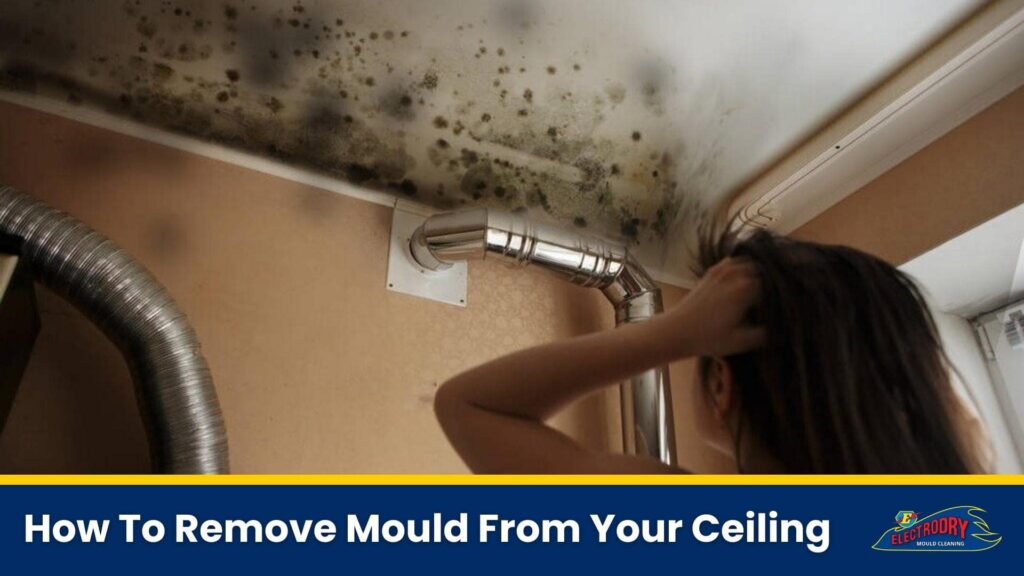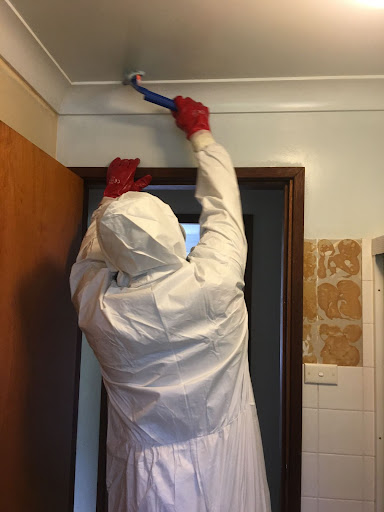How to Remove Mould from Your Ceiling

Mould is a common issue that many households face, especially in damp or poorly ventilated areas and regions with humid climates. Over time, mould can cause various health problems, damage to your home, and an unpleasant living environment.
The growth of ceiling mould is particularly problematic as it can spread quickly and often goes unnoticed until it becomes a bigger issue. So, it’s essential to get rid of mould as soon as possible. Thankfully, cleaning your ceiling and getting rid of mould isn’t actually that difficult.
In this article, we’ll explore some of the best ways to remove mould from your ceiling, using both natural remedies and professional mould cleaning products. We’ll also discuss the essential items you’ll need for the job as well as important safety precautions. If the options below do not work for you, or the mould problem is too severe, you should opt for a professional mould cleaning service, such as Absolute’s affordable and revolutionary mould cleaning system.
Safety Gear
- Gloves: Use gloves made from durable material such as nitrile or rubber to protect against direct contact with mould and cleaning products.
- Eye protection: Safety goggles will protect your eyes from mould spores and cleaning solutions.
- Face mask: A mask, preferably an N95 respirator that filters out airborne particles, is crucial to avoid inhaling mould spores.
Cleaning Supplies
- Scrubbing brush or sponge: Using a stiff-bristled brush can help you break up stubborn mould colonies. Use a step ladder or a long-handled brush to make sure you can reach the ceiling.
- Spray bottle: You’ll need a spray bottle to apply the cleaning solution to the mouldy area.
- Lint-free/microfibre cloths or towels: Use these to wipe and dry the ceiling after cleaning.
- Plastic sheeting and tape: Cover the floor or any nearby furniture to protect them from cleaning solutions and mould spores.
Mould Cleaning Products
| Natural Options | Professional Products |
| Vinegar | Concrobium Mould Control Spray |
| Bicarbonate of soda/ baking soda | Ajax Professional Mould Remover |
| Tea tree oil | Selleys Rapid Mould Killer |
| Hydrogen peroxide |
Steps to Remove Mould From Your Ceiling
Safety first!
Before you start, put on all of your protective gear. You should also protect the area below the mouldy ceiling with plastic sheeting. Remove any furniture or items that could be damaged.Prepare the cleaning solution
Depending on your choice of product (natural or professional), prepare the solution as instructed. See below for more details on each option.Apply your cleaning solution
Using the spray bottle, generously wet the ceiling with the cleaning solution. Let it sit and penetrate the mould for the appropriate amount of time – this will vary depending on your cleaning solution.Remove the mould
After soaking the area, scrub vigorously with your lint-free/microfibre cloth or scrubbing brush. Try to remove as much mould as possible.Repeat
If the mould is still visible, repeat steps 3 and 4 until all the mould is completely gone.Dry the area
Once you have successfully cleaned the mould from the ceiling, you need to dry the area thoroughly to prevent moisture build-up. Use a clean, dry cloth or a dehumidifier to help speed up the drying process.Note: If the mould has caused stains on the paint or finish, you may need to repaint the affected area once it is completely dry.Check the area regularly
Regularly checking and cleaning areas where mould is prone to grow can help prevent its growth and ensure a healthy living environment. If you notice any signs of mould growth, address it immediately to prevent it from spreading any further.
Preparing and Applying Cleaning Solutions
Natural Options
The most popular natural options include vinegar, bicarbonate of soda (baking soda), and tea tree oil. Natural cleaning products are not only easy to find and use, but they’re also more eco-friendly and cost-effective.
- Vinegar: White vinegar is an acidic substance that acts as a natural disinfectant and effectively kills most species of mould spores. Fill a spray bottle with undiluted vinegar and apply it to the mouldy area. Let it sit for one hour and then scrub and wipe the area clean.
- Bicarb soda: This mild alkali is a natural deodoriser and effective mould cleaner. It also helps to prevent mould regrowth. Add a teaspoon (± 5 ml) of bicarb soda to a spray bottle filled with water, shake well, and apply it to the affected surface. Scrub away the mould and then wipe the surface clean with water.
- Tea tree oil: A natural fungicide, tea tree oil can kill mould spores and prevent regrowth. Mix one teaspoon (± 5 ml) of tea tree oil with one cup of water in a spray bottle, shake well, and spray on the mouldy area. Let it sit and work for an hour, then wipe the area clean with a damp cloth.
Professional Products
Natural options do not always work as effectively on older or extensive mould infestations, and may not work on black mould. Instead, professional products or mould remediation experts may be necessary to ensure complete mould removal and prevention. Here are some examples of worthwhile professional mould cleaning products:
- Concrobium Mould Control Spray: This non-toxic and eco-friendly mould cleaner not only eliminates existing mould, but it also creates a protective barrier that prevents mould from returning. Spray the product onto the affected surface, let it dry, and then remove any mould residue with a cloth or brush.
- Ajax Professional Mould Remover: This fast-acting solution removes tough mould spots and mildew stains from surfaces in seconds. Spray the product onto the mouldy area, let it sit for 5 minutes, and then wipe the surface with water.
- Selleys Rapid Mould Killer: This is another fast-acting solution to eradicate mould. Spray the product onto the affected area, leave it to work for 3 minutes, then wipe or scrub off.
- Hydrogen peroxide: Hydrogen peroxide is a powerful disinfectant and can effectively remove mould from the ceiling. Decant concentrated hydrogen peroxide into your spray bottle, and spray on the mouldy area. Leave it on for a few minutes before wiping it clean with a cloth.
Remember to read all product labels carefully and follow all safety precautions.
Tips and Prevention
- Control indoor moisture levels: To prevent mould growth, ensure proper ventilation in rooms with high humidity levels – key target areas include bathrooms, kitchens, and laundry rooms. Use exhaust fans (extractor fans) or open the windows when cooking, showering, or doing laundry. To reduce moisture in the air, hang your wet or damp laundry up outside or in a well-ventilated area whenever possible.
- Keep indoor humidity levels below 60%: Mould typically grows at 70–80% humidity, so air out your home as much as possible. Air conditioners and dehumidifiers can also be used to dry out the air if necessary. And whenever you notice a water leak or spill, clean and dry the area immediately.
- Keep your home clean and well-maintained: Regularly clean surfaces, especially in damp areas like bathrooms, and scrub mould-prone spots like grout lines and shower curtains. Moreover, schedule routine inspections and repairs for your roofing, gutters, and plumbing system to avoid water damage and mould growth.
- Bathrooms: Bathroom ceilings and walls are notorious when it comes to mould. So, make sure your bathroom is well ventilated.
- Open windows and doors – leave windows open overnight whenever possible
- Use a fan during and after showering – a standing fan would also work if you don’t have an extractor fan
- Wipe down the shower walls and bath after use – mould loves dampness
- Use mould-resistant paint, drywall, or wallpaper – they contain material that helps to prevent moisture and mould on ceilings
- Perform regular checks and clean mould as soon as possible – the earlier you catch it, the easier it will be to remove.
- Identify and eliminate the source: It’s important to identify the source of moisture that is causing the mould to grow. Fix the leak or the cause of the moisture before you start cleaning the mould.
- For stubborn or extensive mould growth: Consider using a professional mould cleaning product or replacing affected areas, such as paint or plaster.
- Don’t use bleach: Bleach is frequently identified as an option for targeting mould and any cleaning related to a fungus; however, as a toxic substance, it can often cause damage and may not effectively remove mould from ceilings. Bleach can work on non-porous materials and will clean the surface mould, but this is only a temporary solution. According to mycologist Heike Neumeister-Kemp, bleach only removes the colour – masking the fungi, but not killing it. You will likely notice its “return” to your walls and ceilings within two months.
If you think your home needs a professional’s touch, call our friendly Absolute team on 1300 902 362 or make a booking online.

